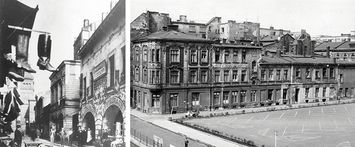Building no. 60

The house at the front of the parcel (on the Velká Street side) underwent adaptations in 1901. The work included structural reinforcements and the replacement of the floors, but the main changes were to the building’s exterior, which was remodelled in a Secession style featuring plant motifs based on a design by the young architect Karl J. Benirschke (1875–1941). At the time, Benirschke was still studying at Otto Wagner’s school of architecture, which formed part of the Academy of Fine Arts in Vienna. He even published the plans in the architectural periodical Architektonische Monatshefte. In 1910 the building was purchased by Rudolf Haberfeld, who (like his brother Markus before him) ran an inn there. The entrance to the private parts of the building was from Pivovarská Street, and the entrances to the inn were on Dlouhá Street and Velká Street. In the following year, Haberfeld and his wife added an extra floor to the two-floor part of the building facing onto Dlouhá Street; the work was done by the Ostrava building contractors Ulrich & Schön.
The economic boom of the mid-1920s impacted on the quality of Ostrava’s hospitality and entertainment businesses. In 1923 Rudolf Haberfeld had part of the rear building (fronting onto Pivovarská Street) converted into a cabaret with the exotic name Alhambra and a capacity of 107 people. When he died in 1935, his wife Hermína continued to run the business. However, she lost the building at the beginning of the Second World War; in March 1940 it was formally purchased by the city for 660 000 Reichsmarks. The building was never returned to the Haberfeld family; Hermína died in 1942 at the Treblinka concentration camp. The Alhambra café and cabaret continued to operate until 1949. In 1951 the building was taken over by the Czechoslovak Construction Corporation, which converted the former cabaret into accommodation for workers. In 1967, although the demolition of the building had already been approved, a pub for miners was set up in the part facing onto Dlouhá Street. The building remained standing until 1973, but it was demolished soon afterwards.
Akce: Otevřít verzi pro tisk
